New Zealand1 & 2 according to CNN3 is now the second best tourist destination
in the world, with Wellington (New Zealand's capital city), a 'great kind
of springboard' to the rest of the country. Wellington is also (according
to Lonely Planet4) one of the coolest little capitals in the world.
So, armed with that background, and a chance to participate in Sundials
on the Internet5 and the British Sundial Society6 Sundial Trail competition,
my friend Robyn Pearce, and I, Rosaleen Robertson, created The Wellington
Sundials Trail. A word for those who have never given sundials a second
thought before now, whatever your interests: scientific, aesthetic, historical,
keeping fit or discovery, our promise is that you will not be disappointed.
You just need to give it a go. A note of caution however, the pursuit
of sundials has been known to be quite infectious and you too could find
yourself a committed sundialophile7 like me. And with this in mind I've
provided some tips Appendix A. (Appendix A, B and C are in a separate
pdf file here) Appendix B provides
details of the numbered references shown in superscript.
So to get started you need to know that New Zealand (Latitude 40.00
degrees south of the Equator and Longitude 174 degrees east of Greenwich)
is one of the first countries to welcome the sun and the new calendar
day. Northern hemisphere visitors, who know about sundials, will immediately
notice the sundial faces are back to front 'down under' 8. The gnomon
(for the uninitiated, the pointer) faces north and the rising sun casts
the morning time shadow off the style onto the left hand side of the face,
completely opposite to northern hemisphere dial, and New Zealand observes
a longish period of daylight saving9 which during our summer is one hour
ahead of Greenwich mean time plus 12 hours (all up 13 hours difference).
All in all we have mapped out for you a trail of twelve sundials. For
ease of navigation Robyn set the trail up on an iPad using Google Maps
and we've included the links for you to use (Appendix C). You can start
at any one of the dials but we decided on The Frank Kitts Memorial Sundial
(#1) on the city waterfront park as our hub.
It took Robyn and me seven hours to complete the trail of eleven sundial
locations. We were 'going for it'; it was a Sunday (so no parking or traffic
issues, but disappointingly it was raining) so we suggest giving yourself
two good two-half days, unless you are in a hurry, so you may enjoy the
city on foot one day, and take your time driving to the dials outside
of the CBD on the other. To summarise:
Part one: six central city sundials
which can be accessed either on foot or by car (driving distance approximately
8 kms).Types of sundial includes: include horizontal, vertical, analemmatic
and an armillary sphere.
Part two: four surrounding sundials which are best accessed by car,
a driving distance of approximately 83.5 kms. Types of sundials include equatorial and
horizontal.
Part three: an additional horizontal sundial in Picton, which we couldn't
resist including, just in case you are making the crossing of Cook Strait
by ferry between the North and South Islands.
We trust you will really enjoy undertaking the Wellington Sundials trail
as much as we have creating it; please feel free to give us your feedback
by making a comment via the Sundial Association New Zealand website 10
or emailing info@sundails.org.nz
A bird's eye view of the Wellington Sundials Trail (acknowledgement
is due to Google Maps 2011). Please access details: clickable link to
a Google Map and instructions: Appendix C ref: # 0
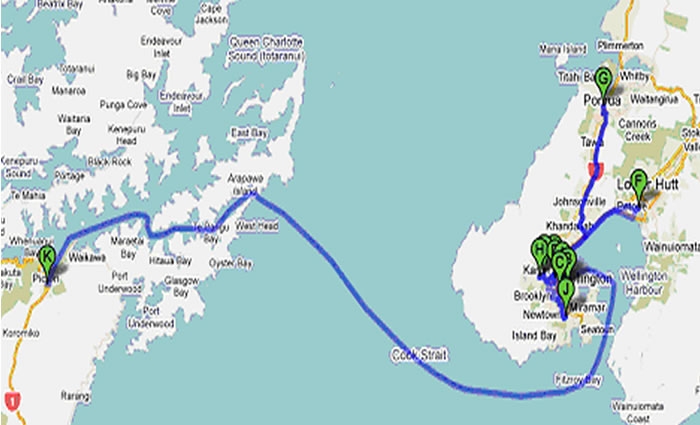
Part one
# 1 Frank Kitts Memorial Sundial, Frank Kitts Park, Jervois Quay
Driving southward down Jervois Quay, Central Wellington, public parking
is usually available under Frank Kitts Park in a Wilson car park: look
past the signpost to the TSB stadium on your left and immediately before
the pedestrian over-bridge. Please access details: clickable link to a
Google Map and instructions: Appendix C ref: # 1
The horizontal sundial is located atop of the car park in a large waterfront
park. In fact you could almost miss it as the pedestal blends with the
park paving, wall and seating surrounds. Look for the landmark, a distinctive
sculpture, by Paul Dibble 'fruits of the garden' facing the inner harbour,
that will put you within 12m of the sundial. Located up the steps, -41.2877
+174.7791 ( iPad).
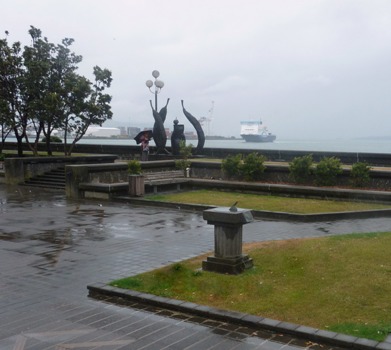
The face and gnomon is bronze, Roman numerals range from 6am to 8pm,
and other furniture includes an equation of time and commemorative plaque
in recognition of Sir Frank Kitts11 who was the longest serving mayor
in the history of Wellington. The plate rests on top of a concrete corrugated
pedestal which was designed and made by Charlie Stone (a NZ stone mason
and sundial maker since1986). The sundial is handsomely well proportioned;
a big solid structure which is perhaps a metaphor of Sir Frank himself.
It sits confidently 'at home' in an open space, clearly being well maintained
by the Wellington Waterfront authority.
The sundial has been shifted from its original site (about 20m south)
where it was commissioned by the Lambton Harbour Development Project in
1990.
#2 Clyde Quay Boat Harbour Reserve, Oriental Parade
Leaving Franks Kitts Park head southward for about 10 minutes along
the waterfront on foot, past the rear of the Museum of New Zealand Te
Papa Tongarewa toward the boat sheds. Please access details: clickable
link to Google Map and instructions: Appendix C ref: # 2.1
If driving, go along Clyde Quay take a left turn into Herd Street off
Oriental Parade. Here you can park directly next to the Oriental Bay boat
sheds in the Waitangi park area near the overseas terminal Caffers Marina.
Please access details: clickable link to a Google Map and instructions:
Appendix C ref: # 2.2
According to the iPad it is located at -41.291151+174.786178.
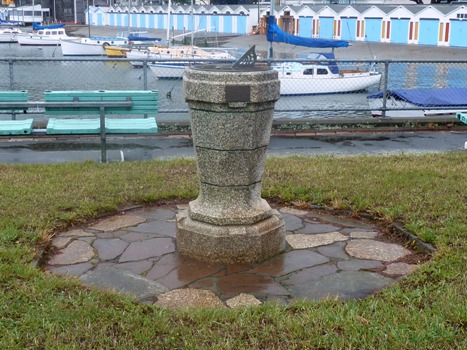 The sundial
pedestal is granite from the Waterloo Bridge, The Thames in London; Waterloo
Bridge London was built in 1817 and demolished in 1937; the granite was
presented to the Wellington City Council by the London County Council.
The horizontal sundial was presented in 1940 by Andrew Fletcher, a former
Harbour Board member. A matching drinking fountain was also presented
with the sundial, however sadly this no longer exists; both were part
of a Wellington city beautification project which Mr Fletcher was a keen
supporter of. Two short newspaper articles of the day are most definitely
worth a read 12 to gain more historical and astronomical information.
The sundial
pedestal is granite from the Waterloo Bridge, The Thames in London; Waterloo
Bridge London was built in 1817 and demolished in 1937; the granite was
presented to the Wellington City Council by the London County Council.
The horizontal sundial was presented in 1940 by Andrew Fletcher, a former
Harbour Board member. A matching drinking fountain was also presented
with the sundial, however sadly this no longer exists; both were part
of a Wellington city beautification project which Mr Fletcher was a keen
supporter of. Two short newspaper articles of the day are most definitely
worth a read 12 to gain more historical and astronomical information.
"Serene I stand admist the flowers to tell the passing of the hours"
is the motto, chosen by Mr Fletcher, inscribed on the face of the dial.
In addition to the motto the detailed bronze face plate includes an equation
of time, Roman numerals from 4am to 8pm, reference to: Mr Fletcher, the
sundial designers CE Adams D.Sc12 and the Wellington Harbour Board, and
a number of directional markers to local and world destinations - Brisbane,
Capetown, London and the Chatham Islands to name a few. The finely engraved
face lends itself nicely to being the subject for a brass-rubbing (Refer
to Appendix A Tips). The vandalized decorative filigreed bronze gnomon
bends slightly right.
To sum up it's an elegant 'art deco'-ish sundial on a matching crazy
paving surround and I think is perhaps one of the city's monumental secrets.
# 3 Logan Brown Restaurant (The National Bank of New Zealand) 192 Cuba
Street
If walking head south east follow these directions: clickable link to
a Google Map and instructions: Appendix C ref: # 3.1 or, if driving be
mindful of the one way roading system, so follow these directions; clickable
link to Google Map and instructions: Appendix C ref: # 3.2, and good luck
with parking.
The location coordinates are: Latitude 41.2948 S and Longitude 174.7746
E.
 A near century
old wall mounted vertical sundial is a rare find in a country as young
as New Zealand. In technical terms it is a north east vertical declining
dial or a "north-east decliner" 12.
A near century
old wall mounted vertical sundial is a rare find in a country as young
as New Zealand. In technical terms it is a north east vertical declining
dial or a "north-east decliner" 12.
It could be easily missed, so after identifying the enormous red front
door (now the entry to Logan Brown Restaurant, no longer The National
Bank of New Zealand13 & 14), look up and you will spot the silhouette
of the gnomon mounted within a moulded frame between Doric posts (alas
the face has been painted out).
Missing its former detail, the sundial is crying out for restoration,
but, before initiating this, I am trying to get the exact details of what
the original sundial face was like. Unfortunately the original1918 plans
lack the necessary detail as all that is recorded on these is an area
for a "bronze plate". The building is a Category 1 Historic Place and
I'm confident some early photographs will come to light.
Botanic Garden Sundials
The Botanic Garden is 25 hectares of unique landscape and home to three15
different types of sundials: analemmatic, armillary sphere and horizontal.
# 4 Sundial of Human Involvement, Carter Observatory, Botanic Garden
If on foot it is under a 20 minute walk from 192 Cuba Street to Lambton
Quay and Cable Car Lane where you hop on the cable car to travel right up
to the Botanic Garden. The Cable Car runs every 10 minutes and is a novel
experience; you'll enjoy a panoramic view for $3.5016. Alight and walk west
so you're heading toward The Carter Observatory and #4 The Sundial of Human
Involvement (follow the clickable link Appendix 4.1.1).
Alternatively you could walk uphill from 192 Cuba Street to The Carter
Observatory, but is a very very long steep haul of1.9km,the time will
depend on your pace and level of fitness,(follow the clickable link Appendix
4.1.2).
If travelling by car you can drive to the top of the cable car, there
is a parking area adjacent to The Carter Observatory (follow the clickable
link Appendix 4.2).
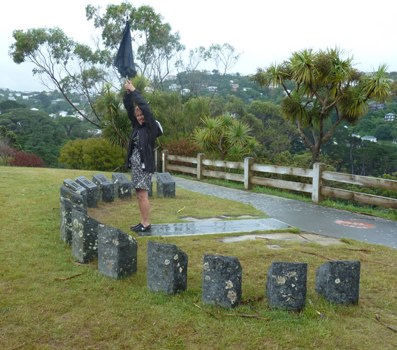 The Sundial
of Human Involvement is outside The Carter Observatory, 40 Salamanca Road
on a north facing grassed area; it is easy to find. This really is a great
'favorite', analemmatic dials such as this uses the shadow of a human
observer, a human gnomon, to cast the shadow (hence the popular name 'sundial
of human involvement'). The person simply stands on the engraved plaque
and follows the instructions, "Stand on the date of the year. With your
back to the sun and your hands together pointed above your head. Your
shadow will tell local standard time."
The Sundial
of Human Involvement is outside The Carter Observatory, 40 Salamanca Road
on a north facing grassed area; it is easy to find. This really is a great
'favorite', analemmatic dials such as this uses the shadow of a human
observer, a human gnomon, to cast the shadow (hence the popular name 'sundial
of human involvement'). The person simply stands on the engraved plaque
and follows the instructions, "Stand on the date of the year. With your
back to the sun and your hands together pointed above your head. Your
shadow will tell local standard time."
This unusual type of horizontal sundial uses a series of fixed granite
marker points which are laid out on an ellipse. The time is shown from
the shadow cast as it crosses the bronze numbered hour points. This particular
sundial is said to be accurate to within a few minutes and no corrections
have to be made for daylight saving because the marker points are physically
moved twice a year. The artist who designed and constructed this wonderful
sundial (1991) is Charlie Stone (see # 1 above). The materials he used,
Takaka granite, bronze, reinforced concrete and steel, have since been
decorated by nature with yellow and green lichen.
The sundial was constructed to commemorate the 150th anniversary of
the Plimmer family in Wellington with funds provided by the Charles Plimmer
Bequest. Mr Plimmer was an early settler and became a prominent businessman
and significant Wellingtonian.
# 5 Centennial Sundial, Sound Shell, Botanic Garden
If walking: continue across the Botanic Gardens in a northerly direction
downward to the next valley. Signposting is excellent or refer to Appendix
B Reference17.
If driving: please follow the directions to 101 Glenmore Street from
the clickable link to Google Maps Appendix C #5
After parking your car enter via the large Centennial Gate; orientate
yourself, it is well sign-posted, and from here simply take the upward
path to the sun dial at the back of the grassed area facing the Sound
Shell.
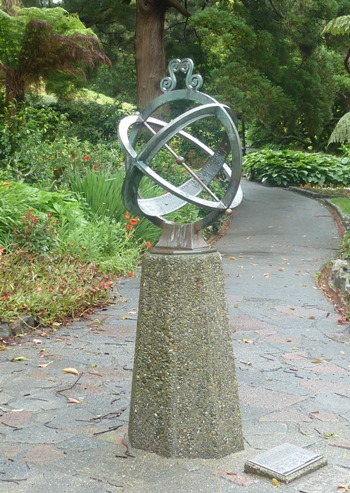 This elegant
bronze armillary sphere is topped off with four perfectly balanced decorative
scrolls. Other furniture includes: a bronze plaque (on crazy paving surround)
which states,
This elegant
bronze armillary sphere is topped off with four perfectly balanced decorative
scrolls. Other furniture includes: a bronze plaque (on crazy paving surround)
which states,
"Centennial Sundial 1881 - 1991 This armillary sphere sundial was commissioned
with the support of the Royal Society of New Zealand and the Wellington
Historical and Early Settlers Association to commemorate one hundred years
of City Council administration of the Wellington Botanic Garden". The
gnomon is a simple rod with a ball at each end and a matching nodus; the
Roman numeral hour scale is etched inside the equatorial ring numbering
from 6am to 8pm and there is an illustrative profile of the brachyglottos
hectori (native tree daisy). The position is Latitude - 41. 16 54 Longitude
174. 45 59
The dial was made by Sundials Australia, Peter Kundycki18 is recorded
as the artist, and it was installed in 1992 resting on a tapered eight-sided
poured pebbly concrete base.
# 6 Herb Garden Sundials, Botanic Garden
Now, retrace your steps to the Centennial Gate; re-orientate yourself and
follow the signs upward to the Herb Garden, a few minutes walk and you'll
be rewarded with a spectacular view looking down on the rose garden.
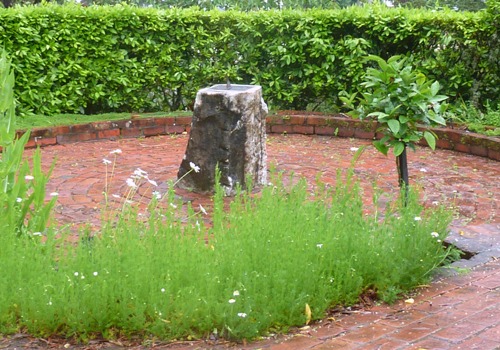 The Herb
Garden sundial is horizontal, the plate is set on a roughly shapen four
sided slab of marble surrounded by a generous circle of old red bricks,
and corresponding walkway, that extends to the end of the herb garden.
The bricks, all 40,000 of them apparently 'free' from a local house demolition,
were transported by volunteers as an incentive to secure funding to establish
the herb garden in 1970. In addition to typical herb garden culinary and
medicinal herbs, Maori medicinal plants are included as well.
The Herb
Garden sundial is horizontal, the plate is set on a roughly shapen four
sided slab of marble surrounded by a generous circle of old red bricks,
and corresponding walkway, that extends to the end of the herb garden.
The bricks, all 40,000 of them apparently 'free' from a local house demolition,
were transported by volunteers as an incentive to secure funding to establish
the herb garden in 1970. In addition to typical herb garden culinary and
medicinal herbs, Maori medicinal plants are included as well.
A bronze plaque on the base records that in 1975 the Wellington Herb
Society presented the sundial19.
The furniture includes: a replacement gnomon which is now bent, Roman
numerals mark the time from 7am through to 5pm, the coordinates Latitude
- 41.17 and longitude +174.47 are recorded on the plate, and there is
a Latin motto, SOL EST LUX ET GLORIA MUNDI20(translated as "The sun is
the light and glory of the world"). There is no maker's mark to be found.
From here retrace your steps, then walk or drive through the Rose Garden,
to return to the city; an interesting steep downhill journey with lovely
views. At this point you have completed half a day's sundial trail.
Part two
If you've got hooked, and hopefully you have and have the time, proceed
to part two for four (or five) more sundial locations. They are all in quite
different directions around the wider Wellington area.
# 7 Te Omanga Garden of Appreciation Sundial, Bracken Street, Petone
Starting out at Petone: go to the clickable link to a Google Map and instructions:
Appendix C ref: # 7.1.
At the end of Bracken Street, Petone, you'll discover such a pleasant
oasis, this garden is tranquil and commemorative; Te Omanga is a Hospice.
The twirping native birds, lovely native trees and an abundance of flowers
are reminders of life, as are the paving bricks each dedicated to someone
who was appreciated and has passed.
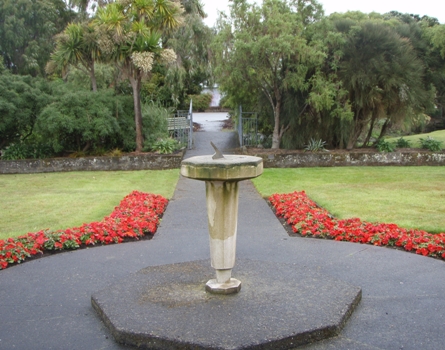 This one
is another bronze horizontal sundial, with furniture that includes a simple
and plain solid gnomon (signs of damage on the left style) an equation
of time and a motto which says, " Washed by the rivers, blessed by the
suns of home. Rupert Brooke, The soldier" .
This one
is another bronze horizontal sundial, with furniture that includes a simple
and plain solid gnomon (signs of damage on the left style) an equation
of time and a motto which says, " Washed by the rivers, blessed by the
suns of home. Rupert Brooke, The soldier" .
About 20m away is a large marble monument to soldiers.
The sundial looks as if it is carefully balanced on a rather wide dais
via an inverted 'needle point' eight sided concrete pedestal. It is positioned
at Latitude -41.222801 Longitude 174.894540.
For sure it is displaying the signs of the wear and tear of time with
evidence of damage, repairs and growths of mould and lichen. Something
about the setting made this one of our 'favourites' and it could be a
pleasant picnic stop.
The next leg is to Petone City.
# 8 Poirua City Council Sundial, Norrie and Parumoana streets
Here are the driving instructions to Poirua City: go to the clickable link
to a Google Map: Appendix C ref: # 8.1
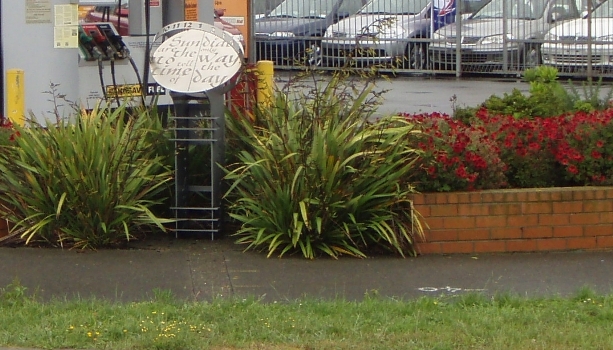 Although
this really delightful modern sundial stands about 1.5 metres high it
is rather difficult to spot from a car, especially as you'll be driving
around a round-about and the sundial is somewhat obscured between native
flax bushes. To help make it less hard-to-find: go to the clickable link
to a Google detailed Map: Appendix C ref: # 8.2.
Although
this really delightful modern sundial stands about 1.5 metres high it
is rather difficult to spot from a car, especially as you'll be driving
around a round-about and the sundial is somewhat obscured between native
flax bushes. To help make it less hard-to-find: go to the clickable link
to a Google detailed Map: Appendix C ref: # 8.2.
Have a peep at what the Poirua City Council says21 the sundial is part
of a bigger sculptural initiative to encourage people to walk around Parumoana
Street and stop and enjoy their surroundings. It was: designed by Andrew
Gray; manufactured by AE Tilleys Ltd and John Kinviq Engineering; and
installed by Gavin Dench.
The sun shines through Arabic numbers onto the face which should be
angled to correspond with the latitude -41.131619. There is a time mark
down the middle of the face and the motto claims that "sundials are the
only way to tell the time of the day". The sundial is constructed from
stainless steel on an iron coated iron stand. The word 'Sundial' is cut
out on both supporting sides of the stand and the back stand features
a cut out sun burst pattern. It is a very skillful piece of artistic work
and has a cheerful rhythm. Without any instructions (it was wet, overcast
Wellington day) and no sun there was a barrier to us solving its workings,
so an expert opinion was obtained:
"The outer ring has perforations which could be called aperture gnomons,
and in this case each perforation is a cut-out hour. Normally the light
from each hour would fall on the corresponding hour mark on the other
side of the equatorial ring so that at 3pm the light from this hour cut-out
will fall on 3pm on the opposite side at 3pm (local time of course).For
your example the flat plate is meant to read the hour when the light falls
on the central line. If you imagine the 3pm case again you will realise
that were it not for the plate, the light would go across the dial to
the other side of the equatorial ring. In the link, the dial is showing
about 11:30 by my interpretation."22
The next and final leg of the trail is approximately 18 kms taking up
to about 25 minutes to travel from Poirua to Karori and the city to two
sundials.
#9 Samuel Marsden Collegiate School Sundial, Junior School,
Karori
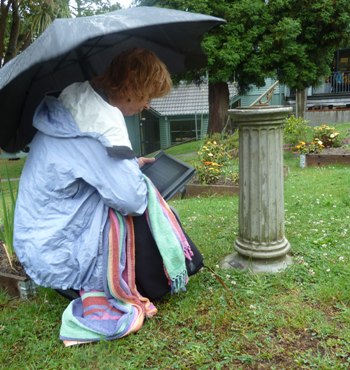
We obtained permission to include this private sundial in The Wellington
Sundials Trail; it is absolutely essential to gain permission to visit
the sundial as you will have to enter private property. Please telephone
00 64 4 476 8707 or email23 well in advance, and during the school term
hours to get confirmation of permission.
For directions to find the School please access the clickable link to
a Google Map Appendix C #9
Do not go up the main school steps; instead go right in the direction
of Karori Road to locate the Lower School mural. Go around to the rear
of the Lower School building. Here nestled in the midst of the little
school children's potager is a miniature horizontal sun dial of the 'mass
made' variety; it is a 'little darling' including a decorative 'brassy'
gnomon and a motto in relief which says "sunny hours amongst the flowers".
A plaque attached states it was "Gifted by Sophie and Anna Watson (1993
- 2004)". The school archivist said they were sisters who attended the
school and daughters of Louise Longuet (nee Watson) also a former pupil
and later a Board member.
# 10 Matthew Holmes Sundial, Karori Cemetery
It is a short run from Marsden Avenue to the Karori Cemetery only 0.9 km
and 3 minutes drive: For directions please access the clickable link to
a Google Map Appendix C # 10.
Enter the cemetery and within 200m and opposite the massive rose garden
on your right you will see a set of wide formal marble steps. These are
below the servicemen's burial area which is south of the Old Karori Road:
go up the two steps inscribed 'lest we forget ' and across the grass,
up another few steps, and there, standing alone in a grand, commanding
and solitary position in an open area over-looking the graves of returned
soldiers, is the large classical sundial.
The sundial comprises a slightly angled concrete base with a bronze
horizontal face. On three sides of the base are molded oval wreaths and
on the fourth side is an inscription:
"this sundial is in remembrance of Mathew Holmes M.D. IRCS LUVT Colonel
NZMC and of his services in Samoa, Gallipoli, Sinai & France. 1914-1918."
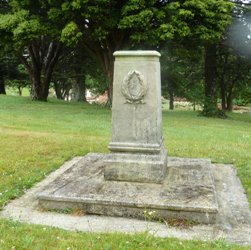 Lieutenant Colonel Matthew Holmes was a respected surgeon at Wellington
Hospital who, along with hundreds of other Wellingtonians, was struck
by the deadly influenza in 'Black November' 1918 and died aged 39. The
monument was erected by his wife in 1920. The motto says Ora et labor
(which means pray and work). The face is very finely and elegantly engraved;
Arabic numbers range from 4am to 8pm. There is no maker's mark.
Lieutenant Colonel Matthew Holmes was a respected surgeon at Wellington
Hospital who, along with hundreds of other Wellingtonians, was struck
by the deadly influenza in 'Black November' 1918 and died aged 39. The
monument was erected by his wife in 1920. The motto says Ora et labor
(which means pray and work). The face is very finely and elegantly engraved;
Arabic numbers range from 4am to 8pm. There is no maker's mark.
The sundial is in need of restoration; unfortunately the gnomon was
missing at the time of our visit (an archival photograph24 of the gnomon
should assist with any replacement initiative) and mould has made the
inscription nearly impossible to read.
#11 Wellington Zoo Sundial, 200 Daniell Street, Newtown
At the time of writing this trail the CEO of the Zoo kindly wrote to advise
that "the Zoo's sundial is not currently located in the visitor space -
it is in the back of house area, so in its current location it is not suitable
for it to be included on this trail".
On an earlier occasion (2009) and viewing, even though the sundial was
'out of commission' the following facts were noted: a large plaque "Commemorates
the valuable services rendered by the Rev. John Crews JP and the Wellington
Zoological Society of which he was the founder and first President."
Wellington Zoo, founded in 1909, is New Zealand's oldest zoo. A bronze
face and long gnomon is mounted on a sturdy classical pillar base.
You are advised to contact the CEO25 to check if the refurbishment
work has been completed and if the sundial is back in situ. These instructions
will get you to the Zoo: please access the clickable Google map Appendix
C # 11.
A reminder, you should also enquire what the entry fee to the Zoo is.
JPG #11 (not supplied)
Part three
And lastly, just as an extra for anyone crossing Cook Strait
# 12 Holy Trinity Church Sundial, Picton
The Holy Trinity Church sundial is located off Nelson Square, Wairoa Road,
at 38 York Street, 1.4 kms and 4 minutes drive to the Picton Ferry Interislander
terminal. This an antique sundial; the Historic Places Trust has 'classified'
it; and their report makes fascinating reading26. Here is a descriptive
excerpt:
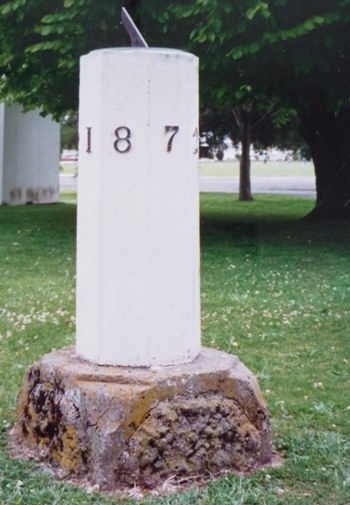 "An eight pointed brass compass rose adorns the centre of the dial,
encircled by equation of time scales within the outer hour-ring. The hour-ring
is engraved with Roman numerals from 4am to 8pm… The dial is configured
for latitude of 41°17'30'' (S), and is inscribed with the signature 'Troughton
& Simms, London'. It is set on a white painted octagonal pillar displaying
the date… (1872) on its side in brass.27"
"An eight pointed brass compass rose adorns the centre of the dial,
encircled by equation of time scales within the outer hour-ring. The hour-ring
is engraved with Roman numerals from 4am to 8pm… The dial is configured
for latitude of 41°17'30'' (S), and is inscribed with the signature 'Troughton
& Simms, London'. It is set on a white painted octagonal pillar displaying
the date… (1872) on its side in brass.27"
The motto is engraved within a ring on the face plate: Watch - Slower
Watch - Faster Watch - Slower Watch - Faster .
For travelers to Wellington, you'll berth at the Wellington Ferry Terminal;
it is a 2.9 km 5 minute drive to # 1 Frank Kitts Memorial Sundial. For
instruction please access the clickable link to a Google Map and instructions:
Appendix C ref: # 12
Here is photo taken in 1993.
 For
a full overview click
here
For
a full overview click
here  For
a full overview click
here
For
a full overview click
here